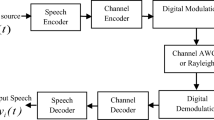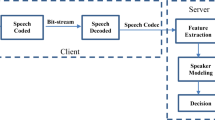Abstract
The main novelty of this work resides in incorporating a Gammatone filter-bank as a substitute of the Mel filter-bank in the extraction pipeline of the Product Spectrum PS. The proposed feature is dubbed the Gammatone Product-Spectrum Cepstral coefficients GPSCC. Experimental results are undertaken on TIMIT and noisy TIMIT corpora using the Gaussian Mixture Model with Universal Background Model (GMM-UBM) recognition algorithm. Performance evaluations indicate that GPSCC shows a drastic reduction in Equal Error Rates compared to other related features and this gain in performance is more pronounced at low signal to noise ratios. Also, our study demonstrates the merit of the Gammatone filter-bank in improving robustness to codec-degraded speech at different bit rates. Furthermore, the proposed GPSCC feature achieves the best verification performance under aggressive compression. Interestingly, at 6.60 kbps we observe that GPSCC achieves an absolute error reduction of 12% compared to the Mel Frequency Cepstral Coefficients (MFCC).








Similar content being viewed by others
Notes
Code available at: http://cs.uef.fi/pages/tkinnu/VQVAD/VQVAD.zip.
References
Alsteris LD, Paliwal KK (2007) Short-time phase spectrum in speech processing: a review and some experimental results. Digit Signal Process 17(3):578–616
Asbai N, Bengherabi M, Amrouche A, Aklouf Y (2015) Improving the self-adaptive voice activity detector for speaker verification using map adaptation and asymmetric tapers. Int J Speech Technol 18(2):195–203
Boulkenafet Z, Bengherabi M, Nouali O, Cheriet M (2013) Using the conformal embedding analysis to compensate the channel effect in the i-vector based speaker verification system. In: 2013 International Conference of the BIOSIG Special Interest Group (BIOSIG), pp 241–248
Brummer N, Burget L, Ernock JH, Glembek O, Grezl F, Karafiát M, Strasheim A (2007) Fusion of heterogeneous speaker recognition systems in the STBU submission for the NIST speaker recognition evaluation 2006. IEEE Trans Audio, Speech, Lang Proc 15(7):2072–2084
Brummer N Focal: Tools for Fusion and Calibration of automatic speaker detection systems. http://www.dsp.sun.ac.za/nbrummer/focal
Davis SB, Mermelstein P (1980) Comparison of parametric representations for monosyllabic word recognition in continuously spoken sentences. IEEE Trans Acous Speech Signal Process 28(4):357–366
Dehak N, Kenny P, Dehak R, Dumouchel P, Ouellet P (2011) Front-end factor analysis for speaker verification. IEEE Trans Audio Speech Lang Process 19 (4):788–798
Dimitriadis D, Maragos P, Potamianos A (2011) On the effects of filterbank design and energy computation on robust speech recognition. IEEE Trans Audio Speech Lang Process 19:1504–1516
Fedila M, Amrouche A (2012) Automatic speaker recognition for mobile communications using AMR-WB speech coding. In: 11th international conference on information science, signal processing and their applications ISSPA. IEEE, pp 1034–1038
Fedila M, Harizi F, Bengherabi M, Amrouche A (2014) Robust speaker verification using a new front end based on multitaper and gammatone filters. In: Tenth International Conference on Signal Image Technology and Internet-Based Systems (SITIS). IEEE, pp 99–103
Fedila M, Bengherabi M, Amrouche A (2015) Consolidating product spectrum and gammatone filter-bank for robust speaker verification under noisy conditions. In: International Conference on Intelligent Systems Design and Applications (ISDA). IEEE, pp 347–352
Fernndez Gallardo L (2016) Human and automatic speaker recognition over telecommunication channels. Springer Science Business Media
Gallardo LF, Wagner M, Mller S (2014) Advantages of wideband over narrowband channels for speaker verification employing MFCCs and LFCCs. In: Fifteenth Annual Conference of the International Speech Communication Association, pp 1115–1119
Gallardo LF, Wagner M, Mller S (2014) I-vector speaker verification for speech degraded by narrowband and wideband channels. In: Proceedings of Speech Communication 11. ITG Symposium. VDE, pp 1–4
Gerkmann T, Krawczyk-Becker M, Roux J (2015) Phase processing for single channel speech enhancement: history and recent advances. IEEE Signal Process Mag 32(2):55–66
Gold B, Morgan N, Ellis D (2011) The auditory system as a filter bank, speech and audio signal processing: processing and perception of speech and music. Wiley
Hegde RM, Murthy HA, Gadde VRR (2007) Significance of the modified group delay feature in speech recognition. IEEE Trans Audio Speech Lang Process 15 (1):190–202
Ireland D, McBride S, Knuepffer C (2015) Adaptive multi-rate compression effects on vowel analysis. In: Bioengineering and biotechnology, vol 3
Recommendation G (2003) 722.2: Wideband Coding of Speech at around 16 kbit/s using Adaptive Multi-Rate Wideband (AMR-WB)
Kenny P, Boulianne G, Ouellet P, Dumouchel P (2007) Joint factor analysis versus Eigenchannels in speaker recognition. IEEE Trans Audio Speech and Lang Process 15(4):1435–1447
Kim C, Stern RM (2016) Power-normalized cepstral coefficients (PNCC) for robust speech recognition. IEEE Trans Audio Speech Lang Process 24:1315–1329
Kinnunen T, Rajan P (2013) A practical self-adaptive voice activity detector for speaker verification with noisy telephone and microphone data. International conference of acoustics speech and signal processing. In: ICASSP, pp 7229–7233
Kinnunen T, Saeidi R, Sedlak F, Lee K A, Sandberg J, Hansson-Sandsten M, Li H (2012) Low-variance multitaper MFCC features: a case study in robust speaker verification. IEEE Trans Audio Speech Lang Proc, pp 1990–2001
Li Z, Gao Y (2015) Acoustic feature extraction method for robust speaker identification. Multimed Tools Appl 75(12):1–16
Li Q, Huang Y (2011) An auditory-based feature extraction algorithm for robust speaker identification under mismatched conditions. IEEE Trans Audio Speech and Lang Process 19(6):1791–1801
Madikeri SR, Talambedu A, Murthy HA (2015) Modified group delay feature based total variability space modelling for speaker recognition. Int J Speech Technol 18 (1):17–23
Martin A, Doddington G, Kamm T, Ordowski M, Przybocki M (1997) The DET curve in assessment of detection task performance. National Inst of Standards and Technology Gaithersburg MD
Mclaren M, Abrash V, Graciarena M, Lei Y, Pesan J (2013) Improving robustness to compressed speech in speaker recognition. In: INTERSPEECH, pp 3698–3702
Mowlaee P, Saeidi R, Stylianou Y (2016) Advances in phase-aware signal processing in speech communication. Speech Commun 81:1–29
The NIST year 2008 and 2010 speaker recognition evaluation plans, http://www.itl.nist.gov/iad/mig/tests/sre
Paliwal KK, Atal BS (2003) Frequency-related representation of speech. Eighth European Conference on Speech Communication and Technology
Rajan P, Kinnunen T, Hanilci C, Pohjalainen J, Alku P (2013) Using group delay functions from all-pole models for speaker recognition. In: INTERSPEECH, pp 2489–2493
Reynolds D, Quatieri TF, Dunn RB (2000) Speaker verification using adapted Gaussian mixture models. Digit Signal Process 10(1):19–41
Sadjadi SO, Slaneyand M, Heck L (2013) MSR identity toolbox
Sebastian J, Kumar M, Murthy HA (2016) An analysis of the high resolution property of group delay function with applications to audio signal processing. Speech Comm 81:42–53
Tiwari V (2010) MFCC and its applications in speaker recognition. Int J Emerg Technol 1(3):19–22
Linguistic Data Consortium (1990) The DARPA TIMIT Acoustic-Phonetic Continuous Speech Corpus. NIST Speech Disc CD1-1.1
Varga A, Steeneken HJ (1993) Assessment for automatic speech recognition: II. NOISEX-92: a database and an experiment to study the effect of additive noise on speech recognition systems. Speech Commun 12(3):247–251. http://spib.rice.edu/spib/selectnoise.html
Vijayan K, Reddy PR, Murty KSR (2016) Significance of analytic phase of speech signals in speaker verification. Speech Comm 81:54–71
Ying L (2006) Phase unwrapping Wiley encyclopedia of biomedical engineering.
Zhao X, Wang DL (2013) Analyzing noise robustness of MFCC and GFCC features in speaker identification. International Conference on Acoustics Speech and Signal Processing (ICASSP), 2013, IEEE, pp 7204–7208
Zhou X, Garcia-Romero D, Duraiswami R, Espy-Wilson C, Shamma S (2011) Linear versus Mel frequency cepstral coefficients for speaker recognition. In: Automatic Speech Recognition and Understanding (ASRU), 2011 IEEE Workshop, pp 559–564
Zhu D, Paliwal KK (2004) Product of power spectrum and group delay function for speech recognition. In: IEEE International Conference on Acoustics, Speech, and Signal Processing, IEEE, vol 1, pp I–125
Author information
Authors and Affiliations
Corresponding author
Rights and permissions
About this article
Cite this article
Fedila, M., Bengherabi, M. & Amrouche, A. Gammatone filterbank and symbiotic combination of amplitude and phase-based spectra for robust speaker verification under noisy conditions and compression artifacts. Multimed Tools Appl 77, 16721–16739 (2018). https://doi.org/10.1007/s11042-017-5237-1
Received:
Revised:
Accepted:
Published:
Issue Date:
DOI: https://doi.org/10.1007/s11042-017-5237-1




